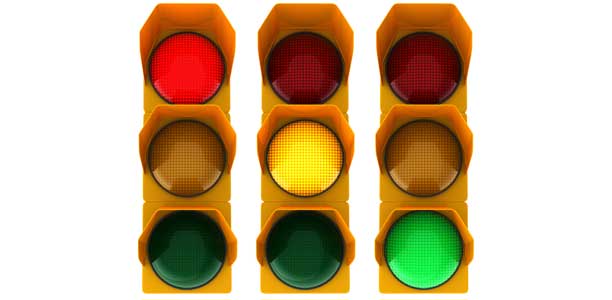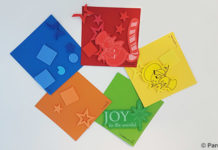Age
This game is suitable for babies who can already walk a short distance unsupported to pre-schoolers who can walk so well that they really need to know about road safety.
Number of participants
You can play this game with one or more children. When more than one child plays you could get them to take turns driving through the traffic lights, as though they were a queue of cars waiting to cross the intersection. Or you could get them to stand in a line and hold the shoulders of the person in front and pretend they are in a car together. The person in front holds the steering wheel (a paper plate) and the children can take turns being in the driver.
Duration of game
You can play this game for just a couple of minutes, or up to half an hour.
Materials/equipment (if applicable)
- Traffic light template below
- Colour printer
- Laminator and laminating slips
- Blu-tac
- Paper plate (one per child)
Alternative cheaper version
- Paper
- Plastic cup
- Coloured crayons/pencils
Cost
$4
Printing and laminating the traffic lights will cost about $2.00 and a pack of paper plates will cost about another $2.00 although you’ll only need one plate per child.
If you’re strapped for cash but want to make this game, you could use hand drawn and/or unlaminated pedestrian traffic signs (but bear in mind they won’t last as long if they’re not laminated).
Preparation (if applicable)
The car traffic signs template provided is all you really need to play this game. Download the printable version
- Print the traffic light template in colour.
- Laminate the coloured circles traffic light page.
- Print out and laminate the black circles and the cut around them. Stick a piece of blu tac on the back of each one.
- Prepare the traffic light by covering two of the coloured circles with a black circle (the coloured circle which is left uncovered shows what action needs to be taken).
If you don’t have a printer and laminator, make the traffic lights by hand:
- Use a plastic cup with a large opening as a stencil.
- Draw three circles on the length of a sheet of paper, using the cup as your guide.
- Colour the top circle red, the middle circle orange and the bottom circle green using markers, crayons or pencils. If your child is preschool-age you may want to get them to colour the circles themselves.
- Draw two more circles that are the same size (use the same cup). Colour them black (or if you’re short of time just leave the white (or whatever colour your paper is).
- Cut out each of the black circles and put a small piece of blu tac on the back.
- Use one black circle to cover two of the coloured traffic light circles. (The coloured circle which is left uncovered shows what action needs to be taken).
How to play
For additional fun, make a car from an old cardboard box- it won’t cost any extra.
- Cut out the bottom of the box so your child can stand inside the box car.
- Make two straps by attaching string to the diagonally opposite corners- the straps will go over your toddler’s shoulders and hold the box car up off the ground.
- Then get creative and decorate the car. Cut circles for wheels and a steering wheel (use the bottom of the box or another box or paper plates). You could also draw doors and other features, or paint the box, depending on how much time you have and how old your child is.
When your child’s car is ready to drive off, all you need to do is:
- Attach the traffic light to the wall at an appropriate height for your child.
- Your child should stand in their box car at the other side of the room or a short distance away from the traffic lights. If you don’t have time to make the car, just use a paper plate and get them to hold it like a steering wheel.
- Tell your child that they are driving on a busy road with traffic lights and to make sure they don’t have an accident or hit a pedestrian, they need to watch the traffic lights and only go when the green light is on. This is when cars going in the opposite direction have to stop and wait.
- When the red light is on they have to wait because other cars and pedestrians are crossing the road and might collide with them.
- When the orange light is on they need to stop, unless they are already in the middle of crossing.
- Leave one of each of the coloured circles uncovered for each round of the game. Your child should either wait (red light), finish driving through the intersection (orange light) or drive through the intersection (green).
- If your child makes a mistake, talk with them and explain why they should have waited (or gone).
Modifications on how to play
- You can play this game with a group of children by setting up two sets of traffic lights, and organising the children into two groups which drive through the lights in opposite directions. You may need two adults (or an adult and another older child) to be traffic light controllers in this situation. You need to make sure the groups do not both have green lights simultaneously though!
- For an extra challenge, you could ask your slightly older child to cross the intersection backwards, jumping or hopping. These types of movements all require different actions to walking and will develop different muscles.
- The traffic light road safety game is also lots of fun to play outdoors, especially if your child is at that age when they are learning to ride a tricycle or a bicycle. Enlarge the traffic light template or hand-make a large traffic light. Set it up in a place where your child can ride around on their bike easily. But don’t forget to be sun-smart and have your child wear a hat and sunscreen.
Safety concerns
Your child is too young to apply the skills they learn in this game to real life road situations. Supervise them at all times when they are near roads or driveways and make sure you are holding their hand. Also make the most of real life situations to talk to your child about how to cross the road and choose a safe spot to do that. Kids this age learn by watching those around them so setting an exemplary road safety example is important.
Benefits of this game/play
From two years of age your child’s physical growth slows and intellectual development start in earnest. And your child is probably making the most of the growing s/he has already done and using their limbs and muscles to move around constantly. At this age children are always on the go and their attention span is quiet short- they may want to change games constantly. This activity is helps your toddler to develop their muscles and coordination, and also develop intellectually.
Gross motor skills
- As your child is walking through the intersection they will also be developing the gross motor skills needed for walking- their leg muscles will be getting stronger and their walking action will be changing from the flat footed first baby steps to a more adult heel to toe motion.
- Other actions such as honking the car horn or turning the steering wheel can also be incorporated into this game and will help your child develop the big muscles used to control their arms. From about two years of age children develop the coordination to move around and use their hands at the same time and encouraging them to use their hands as they walk through the traffic lights will help improve their coordination.
Fine motor skills
- Involving your child in decorating the box car or steering wheel is a great way to develop their fine motor skills, that is, the skills needed to use the small muscles which control their fingers. Toddlers are just developing the skills to draw and practice makes perfect. Give your child some crayons and get them to experiment with different strokes (e.g. straight and circular) while drawing. Although toddlers look a bit clumsy when they first learn to hold a pencil, these early attempts develop the finger muscles and they should have enough control to put down a good scribble (or their first masterpiece, depending how you view these things).
Spatial awareness
- Spatial awareness refers to the skills needed to be aware of your position in relation to objects, for example to judge how near and far things. It also involves recognition of direction. While spatial awareness is learnt naturally, consciously talking to your child about their position in a space like the traffic lights is a great way to enhance their awareness of space.
- Talk about their location at different times in the game (e.g. at the traffic light, across the intersection) and their relationship of different objects in the space (e.g. whether they are near or far) and you go. For slightly older toddlers you could even measure the distance across the traffic lights by counting the number of steps. This can help teach them the relationship between things like the width of the road and the time it takes to cross the road which will be a vital road safety skill as they get older.
Communication and social skills
- A lot of communication is symbolic and this game will increase your child’s awareness of the symbols which communicate information about the road and how to use it. For example they learn about symbols like red lights which mean stop and green lights which mean go.At this age children are able to differentiate symbols which differ by just a single characteristic (e.g. are exactly the same except for the colour), which makes traffic lights perfect symbols for developing these early differentiation skills.
- Your child is full of energy at this age and getting them to sit or stand still can be a real challenge. Learning to sit patiently at the traffic lights is also helping children develop patience in real life- knowing they need to wait their turn to cross the road can also help them know that they have to wait their turn in other situations.
- This is a great game for teaching your child words which describe spatial relationships, words like at, in, middle and across.
Language development/literacy
- You and your child will be talking to each other as they play this game. It seems like a very simple thing but children learn new words and how to arrange words in sentences through the simple act of talking.
Maths skills
- Your child will learn to recognise different colours, and this is an important early mathematical skill.
- Counting the number of steps or peddle-pushes your child needs to cross the traffic light is a great way to teach them about distance.
- At the same time you’ll be helping them develop their maths skills and master the art of counting.
Download the printable version
References
- Di Pietro G. Child Development and Road Safety- Relationship between age, development and road safety in children aged 0-16 years. Motor Accidents Authority. 2004. (cited 19 January 2013). Available from: URL Link
- American Academy of Pediatrics. The complete and authoritative guide- Caring for your baby and young child- birth to age 5. 5thed. Bantum Books. 2009. (URL Link)
- US Department of Education. Teaching about numbers and counting. In Teaching our youngest- A guide for preschool teachers and child care and family providers. 2007. (cited 13 March 2013). Available from: (URL Link)
- Copley JV, Glass K, Nix L, et al. Measuring experiences for young children. Teaching Children Mathematics. Feb 2004. Full Text: (PDF File)



 (14 votes, average: 4.29 out of 5)
(14 votes, average: 4.29 out of 5) 






